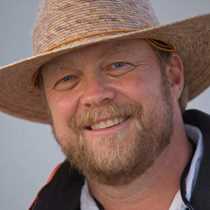Scoresby Sound, Greenland
It has been a surprisingly smooth crossing from Iceland. Just after 5:00am, the National Geographic Explorer emerges from the fog. Greenland is on the horizon, the world’s largest island, and also one of the most remote. A mirage effect makes the icebergs look like white castles guarding the rugged, mountainous coast. Not many ships dare to venture into these icy waters sweeping down from the Arctic Ocean, but this is why we have come – for ice and adventure.
It wasn’t even breakfast time when the call comes from the bridge that whales are sighted ahead of the ship. Scores of seabirds swarm around each blow – kittiwakes, northern fulmars, greater shearwaters –feeding on the same bounty the whales are enjoying. Sharp eyes identify humpback and fin whales, maybe two dozen animals or more. Hunted heavily as far back as the 17th century, these endangered whales are still making a slow comeback, so it’s great to see them in such numbers. The photographers in the group have a field day, trying to get the perfect fluke shot of the humpbacks. One surfaces right off the bow, startling us all. Like a fingerprint, each fluke is unique and identifies the individual whale. Images will be emailed by satellite to researchers in hopes that we can get a positive ID, which will tell us about the migration patterns for this population.
Rounding Cape Brewster, we enter Scoresby Sound, the largest fjord system in the world. And we immediately see why – there are mountains, glaciers, and icebergs in every direction. Flocks of little auks, the most abundant bird in the arctic, fly like little footballs with wings just above the surface of the water. Towering cliffs of layered basalt lava rise steeply from the fjord, with each valley filled with glaciers, rivers of ice coming down from the massive Greenland Icecap. Only Antarctica holds more ice and fresh water.
While marveling at the scenery we are surprised by a swimming polar bear just off the bow, our first sighting of the voyage. During this time of the summer when the pack ice has retreated, bears become champion long-distance swimmers. Swimming bears can become easily overheated, so we glide slowly past, the bear glancing back at us, as surprised as we are.
We marvel at the endless number of waterfalls cascading down the cliff from the hanging glaciers, a reminder that the ice in Greenland is melting faster than anyplace else on each. Scientists speculate that if the ice totally melts, sea level will rise over 20 feet, and Greenland is warming faster than anyplace else on earth. Obviously, this would have catastrophic consequences for low-lying coastal areas and island nations all over the world. During the mid-afternoon we make one particularly close approach to a sculpted iceberg. Each melting iceberg is a work of art, and this particular one is a masterpiece.
We explore with the ship until after dinner, when we drop our fleet of Zodiacs in Viking Bay for a closer look at this desolate but beautiful landscape. We land near ledges of columnar basalt, the same age as the Giant’s Causeway in Ireland, pulled apart by plate tectonics and the opening of the North Atlantic Ocean. Others take to the boats and explore the icy wilderness up close and personal. It’s nearly midnight when the moon peaks through lenticular clouds at twilight, a fitting end to a magical day.




